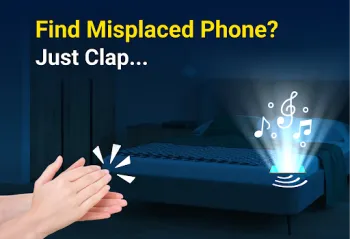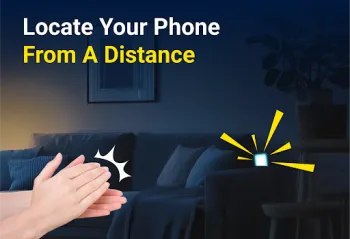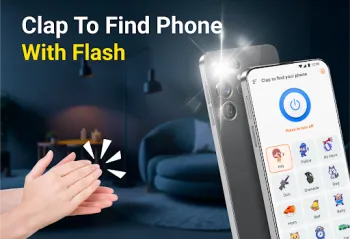Apps Home

Understanding the Technology Behind "Find Phone by Clapping"
The "Find Phone by Clapping" technology utilizes sound detection algorithms to recognize specific sound patterns, such as clapping, to perform an action on the smartphone - typically making it ring or flash. At its core, this involves a combination of audio signal processing and pattern recognition. The microphone of the smartphone constantly listens for patterns that match the predefined clap sequence. This approach distills the complex world of sound into understandable data points and does it in a highly efficient way to preserve battery life. The process begins with the microphone capturing ambient sounds, which are then converted into digital signals. These signals are analyzed in real time by the app. The app's algorithm filters out background noise and focuses on the frequency and decibel level typical of a human clap. Sound energy is computed over short time intervals to match with the known structure of a clap. It's not just the loudness of the clap that matters, but also the acoustic pattern. This involves detecting the peaks and characteristic waveform that a clap produces. To reduce false positives, the app employs machine learning techniques where it learns to differentiate between claps and similar sounds, such as tapping or dropping an object. Over time, advanced versions of the app can even adapt to a user's unique clapping pattern. The detection algorithm is coupled with trigger actions configured to respond when a clapping sound is verified. The smartphone reacts by enabling a pre-set alarm sound or vibration pattern, gauging the user's location through audio triangulation if multiple claps are detected around the phone. Additionally, the camera's flash can be triggered providing a visual cue, further aiding in locating the device, even in the dark or buried under furniture. Despite the complexity, the user experience remains straightforward, reflecting the superior design of the application.
Applications and Use-Cases of "Find Phone by Clapping"
The "Find Phone by Clapping" feature brings a remarkably practical solution to everyday scenarios, enhancing the modern lifestyle by integrating seamlessly into various environments. One of the primary situations where this app shines is within the home environment. Imagine you're preparing dinner, music is playing, and your phone gets lost among the chores. Rather than disrupt your flow, a mere clap can instantly trigger the phone to sound off, easily guiding you to its hidden location amid the kitchen clutter. Alternatively, picture a scenario in a busy office setting, where misplacing your phone amidst a sea of documents and technical equipment can lead to unnecessary distraction. Quick clapping helps you locate it swiftly, allowing pauses to be minimized and productivity to be restored. Exploring further, consider public spaces such as libraries or coffee shops. Phones are often placed on silent mode in such locations. Imagine sipping coffee and glancing around only to find your phone absent. The ability to clap discreetly is invaluable, enabling you to pinpoint the device with minimal disturbance. This feature also offers reassurance when traveling. Taxis, airports, and hotels frequently host instances where personal belongings are easily overlooked. A simple clap can aid travelers in ensuring no electronic treasures are left behind. In terms of unique situations, emergency scenarios should not be overlooked. In case of minor domestic accidents where movements are restricted, the ability to locate a phone through clapping could potentially serve as an intermediary step for contacting help. Additionally, for individuals who may have physical limitations, this feature provides a promising accessibility function, breaking down barriers and promoting independence. These scenarios illustrate the diverse applications of the app, showcasing the utility of sound-based locating technology to reduce the friction of misplaced phones in life’s varied contexts, ensuring it is more than just convenience but a potentially essential tool.
The Technical Challenges and Solutions in Developing Clap AI
Creating the Clap AI application, while innovative, poses several technical challenges that have been adeptly addressed by developers to ensure reliable functionality. One such challenge includes ambient noise interference, which could easily lead to false triggers and necessitates the implementation of robust audio filtering systems. Advanced noise suppression algorithms are employed to distinguish between actual claps and ambient sounds such as conversations or music. Filters preprocess captured audio to reduce interference and isolate intended sounds. Another formidable obstacle is energy management. Constantly listening through the smartphone’s microphone can be resource-intensive, yet the app needs to run efficiently to avoid rapid battery depletion. Developers optimize signal processing algorithms to minimize power consumption by engaging low-power listening modes offered by modern smartphone hardware. These modes allow the app to remain dormant and wake up only when sound input with characteristics similar to a clap is detected. Continuous audio processing runs in the background without significantly affecting device performance. Additionally, ensuring accuracy in sound recognition across different environmental conditions further complicates development. Clap sounds can behave differently based on room acoustics, distance, and proximity to the phone. Machine learning models have been trained to recognize claps despite these variations, learning from extensive data sets of claps captured under diverse scenarios. With real-time processing requirements, computational efficiency is vital, ensuring that processing latency is kept to an absolute minimum. Beyond technical hurdles, the user interface plays a crucial role in translating these sophisticated processes into accessible features. Developers tackle this by simplifying interactions: turning on detection with a single switch, offering clear visual cues during detection, and providing intuitive tutorials that demystify the underlying complexity. These solutions, through their refinement, ensure the robustness and seamless integration of the Clap AI app, allowing users to experience reliability despite inherent technological challenges. The outcome is an application that merges advanced audio processing with user-centric design, delivering a utility that is as dependable as it is innovative.
User Experience and Interface Design of the App
The design philosophy behind the Clap AI app centers on creating an intuitive and seamless experience for users of all ages and technical abilities, making the complex technology behind it appear straightforward. As users open the app for the first time, they are met with a clean and minimalistic interface. It's purposefully designed to avoid overwhelming the user, opting for clarity over complexity. Users are greeted with a primary on/off toggle for the clap detection feature, which embodies the simplicity that the app has aimed to achieve. Upon activation, a visual status indicator reassures users that the phone is in listening mode, conveying the readiness of the app to respond to claps. The visual language is consistent, utilizing color coding to convey states: green for active, and red for off. The integration of customization options remains unobtrusive yet easily accessible. Users have the ability to modify response actions from a designated settings menu. They can select different tones, vibrations, or flashes depending on personal preference or environment needs, each accompanied by brief, explanatory text that demystifies technical terms. As part of the onboarding process, an interactive guide walks users through the best practices for effective clap detection, offering tips on optimal clapping styles and troubleshooting common issues. Comprehensive support is integrated within the app, including FAQs and a feedback system to enhance customer engagement. Beyond this, tactical use of animations subtly reinforces functional transitions, guiding the user subtly without distraction. The app refrains from unnecessary prompts, while allowing easy access to more detailed configurations for power users. Through this delicate balance of simplicity and functionality, Clap AI attempts to cater to a diverse user base, ensuring an experience that is as rewarding for tech-savvy individuals as it is for novices, guaranteeing that the task of finding a misplaced phone is approachable and even enjoyable.
Future Prospects and Innovations in Sound-Based Phone Location Technology
The future of sound-based phone location technology, as epitomized by the footprint laid by applications like Clap AI, presents a landscape rich with potential innovations and developments. The next evolutionary step for these technologies involves leveraging advancements in artificial intelligence and machine learning to enhance the precision and capabilities of audio recognition systems. We are on the brink of applications that could adapt in real-time to evolving sound environments and learn new and unique audio triggers specified by users. This opens doors to customized sound patterns, expanding beyond clapping to personalized sounds like finger snaps or keyword phrases, enhancing the versatility and accessibility of the technology. Moreover, the integration of cross-device functionalities poses another exciting prospect; allowing connected applications to synchronize across multiple devices such as smartwatches, smart speakers, and other IoT devices could vastly enhance user convenience and interaction. Collaborations with wearable technology, particularly, offer intriguing possibilities where sensors could further refine location triangulation, enhancing reliability and accuracy even further. As privacy concerns continue to shape technology, ensuring user data and personal sound patterns remain confidential will be paramount, likely leading to advanced encryption protocols and user-controlled data management interfaces. From another angle, incorporating machine-readable privacy policies could become standard practice, granting users informed control over their interaction data. As developers explore richer contexts of use, experimental interfaces may permit augmented reality interactions, enabling users to visualize sound origins through spatial mapping technologies, thereby providing an intuitive, immersive guide to locating devices. There’s also potential in addressing niche user needs, such as integrating with accessibility tools for those with disabilities, ensuring the digital ecosystem remains inclusive. Complimentary services, like virtual assistants that adapt to the surrounding environment's audio clues, could redefine digital interaction protocols, leading to more naturally attuned and responsive devices. As these innovations unfold, they not only promise to refine the practical utility of today’s applications but also inspire a tomorrow where technology effortlessly integrates into our daily lives, where losing a phone becomes a challenge of the past, solved by the vibrant fusion of human ingenuity and machine intelligence. Experience it today by using features like Download for Android and integrate this transformative technology into your lifestyle.
Share Your Opinion
Your Email Will Not Be Published.
All Rights Reserved © Apps Home 2025




























Gadziawor Mawu
I like this too much, because yesterday I put my in a my store and someone came to buy. When I was selling the thing for the person,l realized that...
Mathew Qadi
I love this app it's amazing Wherever I Go it will make a sound like that's so fascinating and whenever I lose it then it will make a sound which I...
Mr Sharpe
Works very well, and it turned out to be a great time saver, in those odd emergencies when you're in a rush out the door and can't find your phone....
Steve Sawka
you clap, screams like a banshee. awesome. fantastic. perfect. funny. there's a bunch of other sounds to select to personalize your phone finding e...
manda Balreddy
it's good app to find out our phones but If we go to birthday partys and marriages etc. they all will clap on that time also it will horn the sound...